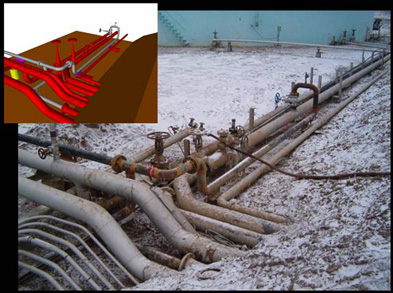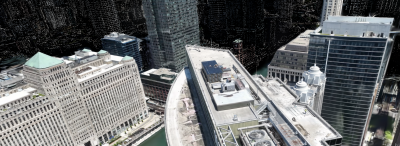Husky Energy Refinery Revamp Project
In February 2001 the Canadian Government unveiled a 10-year plan to reduce air pollution. Clean fuel initiatives primarily aimed at reducing sulfur are a cornerstone of this plan. The regulations require all refiners to produce a gasoline pool with a cumulative sulfur content of 30 parts per million by January 1, 2005. The diesel specifications call for an average of 15 parts per million by July 1, 2006.
Achieving these clean fuel targets requires revamping 40-year-old plus refining assets and infrastructure. Here’s how ProjEx Technologies Ltd. in Calgary used laser scanning technology to minimize field rework and complete the design and installation of new rail and truck loading facilities within the client’s compressed schedule. This project required the addition of significant infrastructure in and around the existing operating Husky Energy Refinery located in Prince George, British Columbia, Canada.
According to Barry Brad, ProjEx co-founder and president, design started on the $5.5 million CDN program in mid-August 2004 with a must-have completion date of January 1, 2005.
3D models for the existing facility – forget about it! According to Ross McDonald, ProjEx project manager, “The engineering/design team decided the aggressive schedule could only be achieved by maximizing shop prefabrication of all components. As a majority of the installation would occur in the operating gasoline tank farms, ProjEx was asked to minimize the ‘hot work’ in and around the operating units. Our experience and previous success working with point cloud data gave us the confidence to proceed with a flanged, bolt-up installation of shop-fabricated spools. Our required tolerance for the 2-inch through 6-inch NPS pipe spools was ¼ inch.”
Field routing and field fit-up of the piping would have eaten too much schedule. In a nutshell, the 8,000 diameter inches of welding and 11,000 lineal feet of prefabricated pipe spools had to show up on the job site and fit without significant field modification. This is the kind of application where laser scanning proves its superiority over manual data collection methods, hands down.
Work process
ProjEx engaged Chris Tucker of laser scanning service provider Focus Corporation Ltd., Edmonton, Alberta, for four days of field data collection using a Leica HDS2500 scanner. Bentley CloudWorx was used to reference the point cloud data, and Bentley’s PlantSpace Design Series modeling software was used to create the CAD geometry for the 3D piping models and subsequent fabrication drawings. Topographic data was also produced from the scan data to support the earthworks cut and fill calculations, as the project required moving 15,000 cubic meters of earth. A portion of the new facilities was located in and around existing high-voltage (69kV) power lines and substation. This existing infrastructure was scanned and the data was used by the design team to ensure that the new facilities were located per the building code and required utilities setbacks and clearances. geovisit();
How did laser scanning help the team get the job done?
I interviewed the ProjEx team on December 16, 2004 – the day before startup and a short 13 weeks after the project broke ground on September 20. How did laser scanning help the team get the job done? Ian Robinson, who handled the CAD/CAE automation and support for the project, says they achieved zero rework on all prefabricated flanged spool pieces where the laser scanning technology was used. Robinson recounted that one of the three 3-inch lines, a 1200-foot-long flanged fit-up routed through an existing pipe rack, took just three days to install.
ProjEx construction manager Paul Gallant goes further to say, “The pipe fitters involved in the installation, although skeptical at the start, were surprised how well the installation of the piping went – this particular installation would have been extremely difficult any other way. As new converts to laser scanning technology, the pipe fitting team felt that field routing and fit-up of such a line would have meant a lot of ‘cutting and hacking’ and thus a significant schedule impact.”
Other benefits that came from laser scanning included the ability to use existing pipe sleeves for routing pipe through the tank farm berms. McDonald estimates that the use of laser scanning for this project saved at least three weeks of construction schedule, allowing ProjEx to meet the client’s aggressive milestones. Any of the other traditional methods of data acquisition would have jeopardized the project cost and schedule. The cost savings realized from eliminating field routing and on-site fabrication are significant.
Husky staff engineering technologist Richard Schreiner is impressed – “The results were remarkable. Everything fit just as planned in some very congested and tight areas. We will certainly use laser scanning technology again when required.”
According to McDonald, careful specification of the project scope is key to successful deployment of laser scanning. There is no getting around having design personnel on site for the data acquisition. “Our engineers and designers better understand the data requirement and accuracy needed to successfully execute the project. We only model tie-in locations and new piping. Utilizing Bentley’s CloudWorx we can prove our pipe routing by using the interference checking tools to determine if we will have problems prior to construction rather than having to model the complete area.” Domain expertise on the surveyor side is also key – according to McDonald, not all land surveyors have the required industrial experience to execute these projects.
Going forward
Brad says that demand for laser scanning is showing strong growth. ProjEx has used laser scanning on four jobs in the past six months, and 2004 was its biggest year ever for using the technology. Going forward, Brad would like to see even more functionality in CloudWorx, for example automatic centerline recognition capability and most certainly tighter integration with Bentley Navigator.
What is holding the industry back? The ProjEx team says there is still a lot of “old 2D CAD” thinking holding people back, and just making the transition to 3D for many continues to be a hurdle.
More successful projects like the Husky Prince George LGC revamp ought to change people’s minds. geovisit();geovisit();






